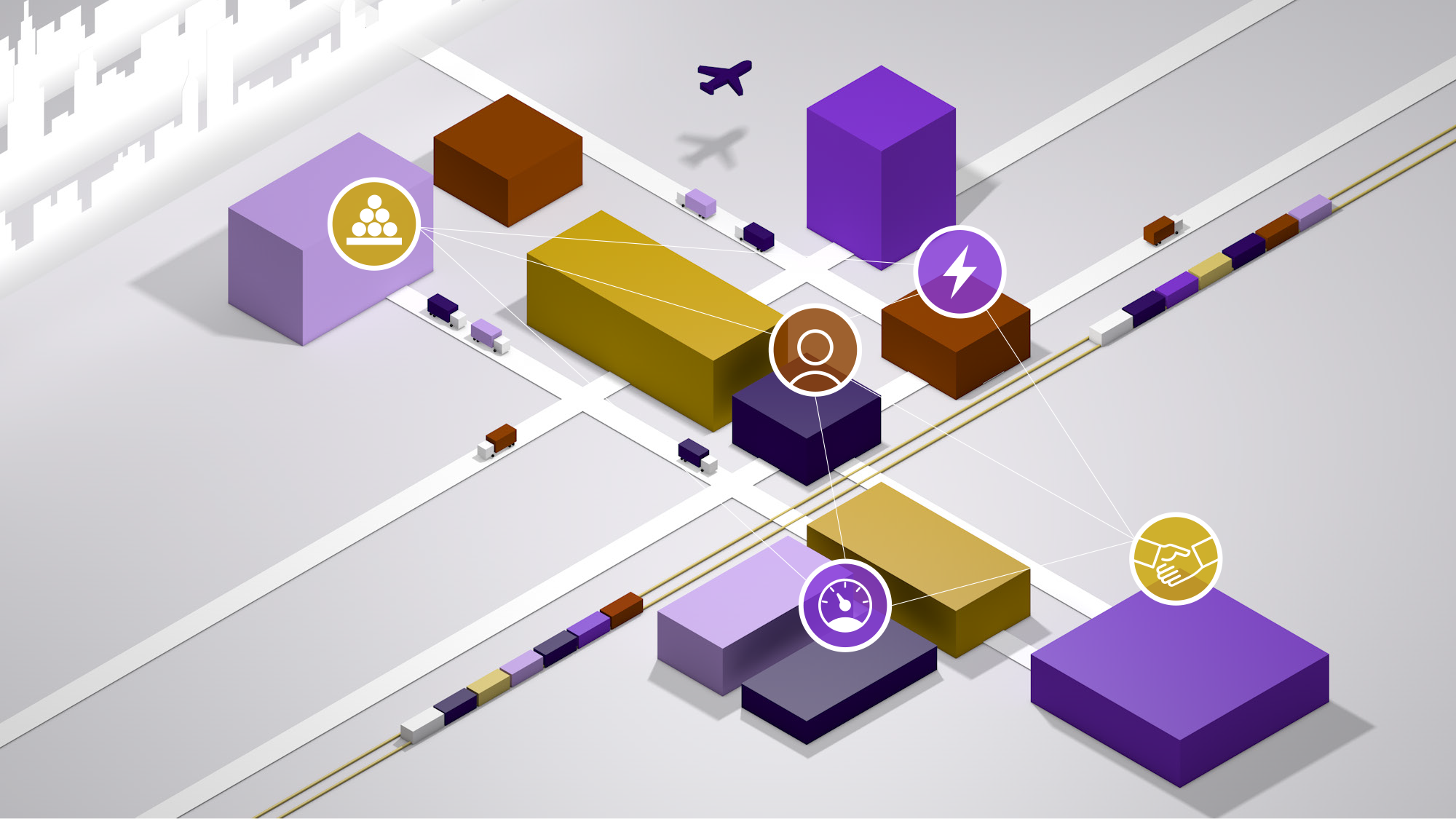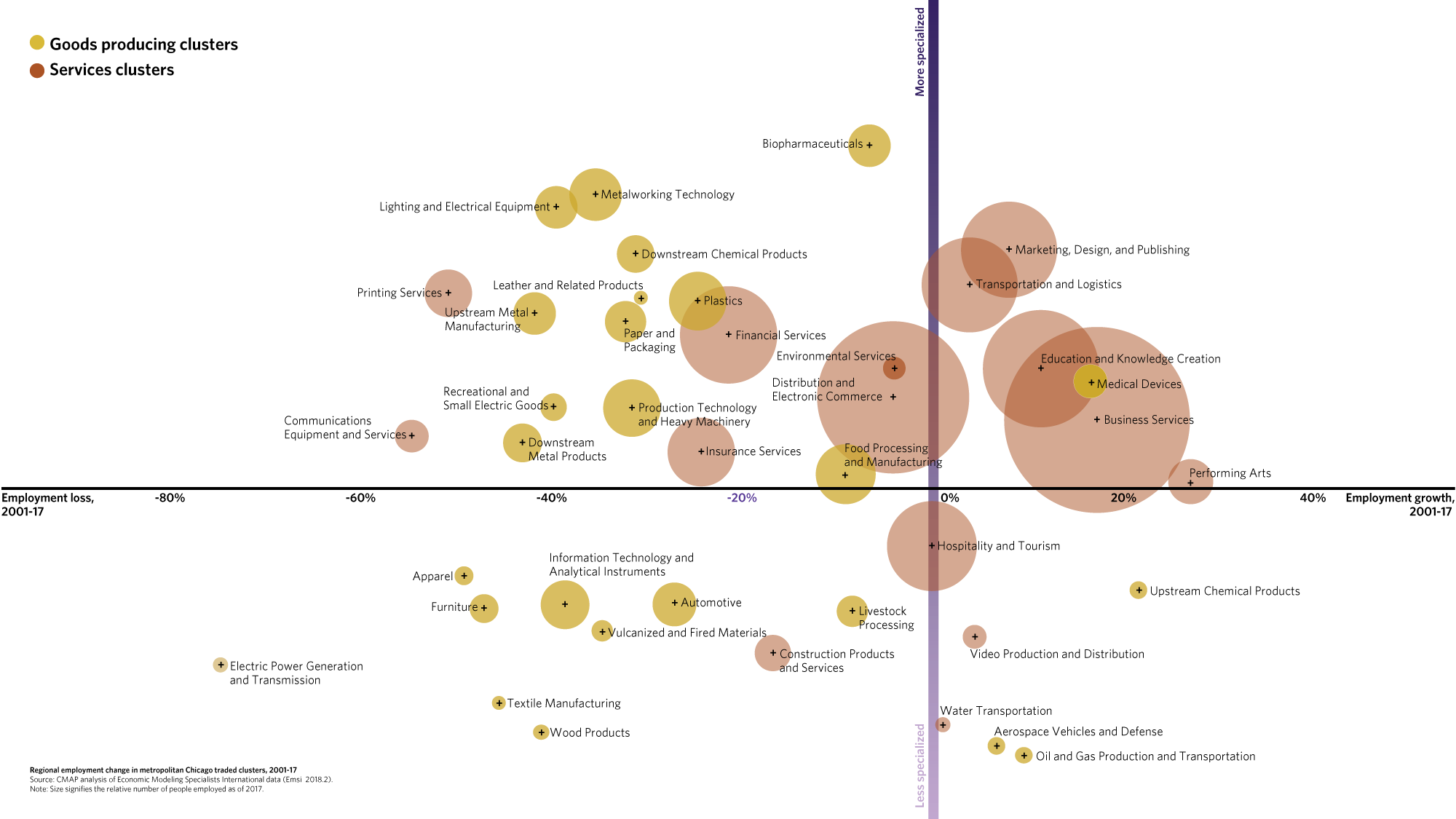Recommendation
Support the region's traded clusters
An industry cluster is a group of firms, related stakeholders, and supportive institutions that gain productive advantages from close geographic proximity and related economies of scale. As groups of related industries grow and develop, clustering can help lower business costs and increase the extent and benefits of specialization. Deeper labor pools, better access to customers and suppliers, knowledge spillovers -- these and other advantages are derived from an environment of balanced competition and collaboration. As a result, specialized industry clusters embedded in metropolitan regions worldwide spur significant economic activity that forges broad economic opportunity and growth. Even in uncertain economic conditions, the competitive advantages of clusters effectively make the case for why a business would choose or need to operate in the Chicago region. A mounting body of research shows that these efficiencies boost a region’s job growth, wages, patenting, and startup activity. In particular, traded clusters -- those selling products and services in markets outside of the region -- have an outsized potential to grow our economy. Traded clusters account for just one-third of the region’s employment but half its income and demonstrate higher rates of productivity, wages, and patenting.
Strategies
The Chicago region realizes significant economic returns through its diverse areas of strength, with employment concentrations above the national average in the majority of traded clusters. Yet the changing global economy has led to declining employment in most traded clusters since 2001. Recent growth has enabled some traded clusters to recover fully from the 2007-09 recession, but longer-term pressures have continued to drive regional employment loss in others. While many factors contribute to industry trends over time, differences between trends here and elsewhere in the U.S. illustrate our region’s relative competitiveness. For example, only a small handful of metropolitan Chicago's traded clusters grew regional employment at or ahead of national averages, most notably Business Services, Transportation and Logistics, and Medical Devices.
The performance of other relatively large clusters has been more mixed, pairing declining employment totals with continued specialization in the national context. Such clusters include Financial Services, Food Processing and Manufacturing, and Metal Manufacturing. In particular, goods-producing industries employ fewer people nationwide than in past decades. But the manufacturing sector remains a core driver of the Midwest’s economy, contributing more to recent growth than consumer spending or the services and construction sectors.
Economic realities are making it increasingly essential that businesses and related public or private institutions work together to support further cluster growth and employment concentration in the region. Regional efforts can address shared, sector-specific challenges like the steepening competition from globalization and the accelerating pace of technological and market changes. Cooperation can also support multiple planning goals like organizing employers and social service providers to implement a regional career pathway system.

The following describes strategies and associated actions to implement this recommendation.
Convene industry leadership and support coordination of cluster initiatives
Clusters occur naturally in the economy as related businesses and institutions enhance productivity through advantages of proximity and interconnectivity. To build their own productivity and resilience, many regions have begun forming cluster initiatives that more deliberately bring together resources to tackle common concerns. Formal initiatives, directed by the needs and interests of the area’s businesses, can provide comprehensive support around the accelerated growth of a specific cluster. Such initiatives include the Chicago Metro Metals Consortium and the Chicagoland Food and Beverage Network. Cluster support can take many forms, such as enhancing educational and training offerings or addressing specialized infrastructure needs. As a result, strategies depend on the unique contexts in which industries operate at regional and sub-regional levels. Private sector leaders -- in partnership with public officials -- have a critical role to play in guiding policy and planning for cluster-oriented economic development. For traded clusters in particular, initiatives should create opportunities for businesses to expand into markets nationally and internationally. CMAP, CRGC, and other relevant entities should regularly convene public and private sector entities to develop systemic support for cluster initiatives.
Conduct additional analysis of the region’s globally traded clusters
Successful economic development depends on improving the region’s competitiveness as a place to do business by increasing the productivity of regional economic assets, including existing firms and workers. Clusters provide a framework for better organizing the many public policies and investments already directed toward economic opportunity and growth. Doing so requires a more detailed understanding of specialized clusters present in northeastern Illinois, and of their unique, often-multijurisdictional needs. Building on momentum from the private sector, this research should aim to serve as a basis for convening industry leadership and identifying initial opportunities for high-impact, cross-cutting collaboration.
Continue to analyze globally traded clusters and apply findings on their unique transportation, land use, innovation, and human capital needs in local and sub-regional plans.
CMAP and research partners
Provide guidance to local partners on best practices for zoning, development, transportation investments, and other tactics that support traded cluster growth.
CMAP and research partners
Pursue inclusive growth by prioritizing clusters that support regional economic opportunity
Inclusive economic growth can improve wages and living standards for the average resident and achieve high participation in a skilled workforce. Yet proponents of cluster-oriented economic development and inclusive growth too often operate in parallel without acknowledging their joint interests. Due to their economic benefits, cluster initiatives can generate economic activity that improves outcomes in underserved or lower income areas, and an emphasis on decreasing inequality could further boost productivity and competitiveness. Likewise, a regional approach to prioritizing cluster support can decrease inequality by raising the demand for labor and increase the effects of policies aimed to spread opportunity. Economic development organizations and partners should take an active role in cluster initiatives, in part to ensure they implement strategies to support inclusive growth. CMAP and partners can make initial efforts to identify and prioritize support to clusters that promote equitable growth in different and diverse parts of the region.
Analyze the planning needs and opportunities of local clusters
Cluster-oriented economic development tends to focus on traded clusters because they serve national and global markets and have significantly higher levels of productivity, wages, and patenting. Some research has also begun to explore the role and needs of industry clusters that serve local businesses and residents. These local clusters provide the economic foundations that businesses in traded clusters rely on to operate. For example, such clusters provide most local healthcare services, education and training, utilities, industrial and vehicle repair services, and local commercial and personal services. These clusters tend to appear in metropolitan areas across the U.S. at concentration levels proportionate to a region’s population and the traded businesses they service.
Both traded and local clusters have discrete functions in the regional economy and distinct infrastructure, land use, and employment needs. Local business-to-business clusters, such as those selling industrial products and commercial services, depend on a transportation system that moves goods efficiently within the region. They also tend to boast higher levels of minority ownership and are well-represented in underserved or lower income areas. Additional cluster-oriented strategies -- such as opening up institutional and corporate procurement chains to a more diverse set of suppliers -- can reflect the broad set of opportunities within local clusters. Further analysis of the region's local industry clusters will help formulate plans to address their challenges and opportunities.
Analyze and plan for the human capital needs of clusters
Many of metropolitan Chicago’s clusters first emerged based on location advantages unique to the region like its central location in the agricultural and industrial Midwest, strong access to a variety of resources, and dense freight infrastructure. These remain some of the region’s strongest competitive advantages. Today, a skilled and adaptable workforce is increasingly important to sustaining and growing the region’s traded clusters. Their continued competitiveness will require coordinated, demand-driven approaches to education and workforce investments. Partnerships between the private and public sectors can help align training programs and hiring practices to ensure clusters have the talent to meet industry shifts.
Human capital is critical to improving the productivity and growth of each cluster, as well as the region as a whole. The value of deep talent pools extend beyond individual firms, as the exchange of ideas within a cluster contributes to higher levels of innovation and productivity. To capitalize fully on the region’s human capital, public and private institutions should continue to foster specialized networks that lead to knowledge spillovers and increase opportunities for innovation. These efforts will require employers to form stronger partnerships with the region’s universities and other institutions of higher education and research.
Prioritize strategies that support the accumulation of human capital in the region, such as cooperation among firms and interaction with education and research institutions.
Cluster organizations, business associations, chambers of commerce, and other industry groups
Work with workforce partners to connect priority populations with supportive services that enable better access to education and employment opportunities.
Cluster organizations, business associations, chambers of commerce, and other industry groups
Coordinate training programs.
Adult education and workforce training providers, with the support of industry
Assist in the articulation of career pathways in key traded clusters.
CMAP, cluster organizations, and regional economic development organizations
Provide data and analysis on job market dynamics in traded clusters.
CMAP
Leverage existing resources, relationships, and institutions to support industry innovators
When complementary firms operate in close proximity, frequent interactions on a variety of levels prompt knowledge spillovers as workers and firms learn from one another without incurring high costs. For example, dense supply chains allow businesses to work directly with their suppliers to customize and improve the inputs required to pursue new ideas. Firms in a cluster are thus better poised to anticipate trends and to adapt their operations by implementing innovations. Cluster-oriented strategies can help spur innovative activity by leveraging existing assets to support new-to-market or new-to-firm innovations. With an educated and experienced workforce, metropolitan Chicago’s traded clusters increasingly compete by offering high value-added, customized, or made-on-demand products and services to a growing global customer base. For businesses to maintain a competitive advantage, the region must commit to investing in new innovations and partnerships that keep our economy at the forefront of such industry trends. Various stakeholders in any given cluster have the capacity to form partnerships that facilitate such idea exchange.
Develop tools to support and foster dense, specialized networks for sourcing supplies, talent, customers, early-stage financing, ideas, services, and other business inputs.
Economic development organizations
Lead efforts to connect regional businesses to their respective innovation systems and assist the dissemination of new technologies and processes.
CRGC or a similar entity, in partnership with local economic development organizations
Provide technical assistance to regional businesses on implementing new advances and reaching global markets.
CRGC, economic development organizations, business associations, and chambers of commerce
Continue to provide resources and expand support for regional cluster-oriented strategies.
Federal and state economic development agencies

